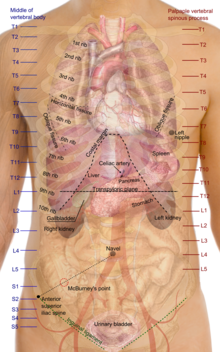Transverse plane
Appearance
This article has multiple issues. Please help improve it or discuss these issues on the talk page. (Learn how and when to remove these template messages)
|
| Transverse plane | |
|---|---|
 The main anatomical planes of the human body, including median (red), paramedian (yellow), frontal or coronal plane (blue) and transverse or axial plane (green) | |
| Details | |
| Identifiers | |
| Latin | plana transversalia |
| TA98 | A01.2.00.006 |
| TA2 | 52 |
| FMA | 12247 71928, 12247 |
| Anatomical terminology | |
The transverse plane or axial plane (also called the horizontal plane or transaxial plane) is an imaginary plane that divides the body into superior and inferior parts. It is perpendicular to the coronal plane and sagittal plane.
It is one of the planes of the body used to describe the location of body parts in relation to each other.
List of clinically relevant anatomical planes
- Transverse thoracic plane
- Xiphosternal plane (or xiphosternal junction)
- Transpyloric plane
- Subcostal plane
- Umbilical plane (or transumbilical plane)
- Supracristal plane
- Intertubercular plane (or transtubercular plane)
- Interspinous plane
Clinically relevant anatomical planes with associated structures

- The transverse thoracic plane
- Plane through T4 & T5 vertebral junction and sternal angle of Louis.
- Marks the:
- Attachment of costal cartilage of rib 2 at the sternal angle;
- Aortic arch (beginning and end);
- Upper margin of SVC;
- Thoracic duct crossing;
- Tracheal bifurcation;
- Pulmonary trunk bifurcation;
- The xiphosternal plane (a.k.a. xiphosternal junction)
- Anterior, inferior limit of thoracic cavity;
- Marks the:
- Superior surface of the liver;
- Respiratory diaphragm;
- Inferior border of the heart;
- The transpyloric plane
- Plane located halfway between the jugular notch and the upper border of the symphysis pubis;
- Typically located at the lower border of L1;
- Cuts through the pylorus and the tips of the ninth costal cartilages;
- The subcostal plane
- Transverse plane through the inferior border of costal margin;
- Typically located at the superior border of L3, or transects L3;
- The umbilical plane (or transumbilical plane)
- Located at the level of L3/L4 vertebral junction or IV disc;
- The supracristal plane
- Located at the level of L4;
- Marks bifurcation of aorta;
- Most superior aspect of iliac crest;
- The intertubercular plane (a.k.a. Transtubercular plane)
- Located at the level of L5;
- Marks origin of IVC;
- The interspinous plane
- Transverse plane which transverses the anterior superior iliac spines.
- Typically located at the level of S1.
